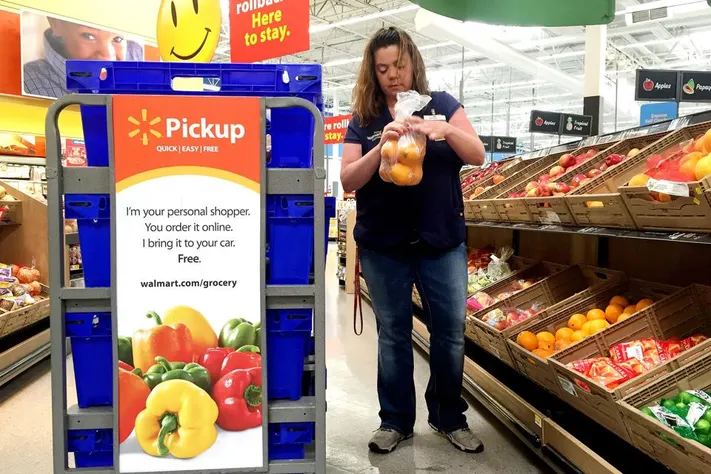In a move aimed at revolutionising customer convenience, Walmart has announced the expansion of its AI-powered grocery pickup system across hundreds of stores in the United States. Building on its existing online ordering and curbside collection infrastructure, the initiative seeks to integrate artificial intelligence into inventory management, predictive order preparation, and personalised customer engagement. The expansion represents a critical step in Walmart’s broader strategy to blend technology with physical retail, enhancing efficiency and customer satisfaction in an increasingly competitive grocery market.
The Evolution of Walmart’s Pickup Strategy
Walmart first introduced online grocery ordering and in-store pickup several years ago, a service that proved particularly vital during the COVID-19 pandemic. Customers could place orders online, schedule pickup windows, and collect groceries without entering the store. While effective, the original model relied on manual processes for product picking and order organisation.
The integration of AI changes this paradigm. Algorithms now analyse real-time inventory data, predict order volumes based on historical trends, and optimise the sequence in which items are collected and packed. This allows store associates to prepare orders more efficiently, reducing wait times and increasing the accuracy of customer pickups.
How AI Enhances the Pickup Experience
Walmart’s AI system offers multiple advantages:
-
Predictive Inventory Management – AI forecasts product demand for specific times and locations, reducing stockouts and overstock situations.
-
Optimised Picking Routes – Algorithms guide staff on the most efficient paths through aisles, saving time and reducing errors.
-
Dynamic Scheduling – Pickup time slots are optimised based on order volume and staffing levels, improving customer wait times.
-
Personalised Recommendations – AI analyses past purchases and preferences, suggesting relevant items for customers, including promotions and seasonal products.
According to Walmart executives, these improvements are expected to enhance both operational efficiency and customer satisfaction. By reducing human error and streamlining workflows, AI-powered pickup creates a more seamless grocery experience.
Why AI Matters in Grocery Retail
The U.S. grocery sector has become increasingly competitive, with traditional supermarket chains facing challenges from e-commerce giants such as Amazon, regional grocers, and online-only delivery platforms like Instacart. Consumers now expect speed, convenience, and accuracy in their grocery shopping experience.
AI provides Walmart with a strategic advantage:
-
Improved operational efficiency – Reduced labour strain and faster order preparation.
-
Higher order accuracy – Ensuring that customers receive exactly what they ordered.
-
Enhanced customer loyalty – Personalised recommendations and reliable service encourage repeat business.
-
Cost savings – Optimised staffing and inventory reduce waste and operational expenses.
In essence, AI allows Walmart to leverage its existing infrastructure more effectively, transforming traditional store formats into highly responsive fulfilment hubs.
Implementation Challenges
Despite the benefits, integrating AI into grocery pickup is not without challenges:
-
Training Staff – Associates must adapt to AI-guided workflows and technology interfaces.
-
Data Accuracy – AI depends on reliable inventory and sales data; discrepancies can lead to inefficiencies.
-
Scalability – Expanding the system to hundreds of stores requires significant IT infrastructure and ongoing maintenance.
-
Customer Adaptation – Consumers must understand and trust the AI-enhanced pickup process.
Walmart has committed to phased implementation, providing staff training and technical support to mitigate these challenges. Pilot programs in select stores have already demonstrated promising results, with faster pickups and improved customer satisfaction scores.
Impact on Consumer Behaviour
For shoppers, AI-powered pickup offers tangible benefits:
-
Reduced wait times – Customers can collect orders faster and more predictably.
-
Fewer errors – Improved accuracy ensures correct products and quantities are delivered.
-
Personalised shopping – AI recommendations can enhance meal planning and introduce new products.
-
Flexibility – Dynamic scheduling allows for pickup at convenient times, including weekends and evenings.
Analysts suggest that as convenience becomes a primary driver of customer loyalty, innovations like Walmart’s AI-powered pickup may shape expectations for the entire grocery sector.
Strategic Significance
Walmart’s investment in AI reflects a broader shift in retail strategy. Physical stores are increasingly being viewed as multifunctional fulfilment centres that serve local communities while supporting e-commerce operations. By embedding AI in these processes, Walmart is:
-
Bridging the gap between online and offline shopping
-
Leveraging data to anticipate consumer demand
-
Enhancing operational efficiency without sacrificing customer experience
This approach positions Walmart not only as a traditional grocery retailer but also as a technology-enabled service provider.
Future Prospects
Looking ahead, Walmart plans to:
-
Expand AI-powered pickup to additional regions nationwide
-
Incorporate machine learning to refine recommendations and optimise inventory further
-
Integrate predictive analytics for supply chain and logistics improvements
-
Explore automation in warehousing and last-mile delivery
The company’s ultimate goal is a fully integrated, intelligent grocery ecosystem where physical stores, online platforms, and AI-driven fulfilment operate seamlessly to meet customer expectations.

